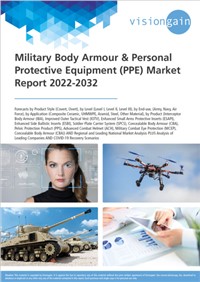The Military Body Armour & Personal Protective Equipment (PPE) Market Report 2022-2032: This report will prove invaluable to leading firms striving for new revenue pockets if they wish to better understand the industry and its underlying dynamics. It will be useful for companies that would like to expand into different industries or to expand their existing operations in a new region.
Trends In Body Armour – Weight Versus Protection
Body armour and helmets have been around since the 16th century when the musket was invented. Body armour and helmets became less popular throughout time since their weight hampered movement. The two World Wars of the twentieth century were fought without the use of body armour. However, because 20% of all fighting casualties were to the head, reasonably efficient helmets emerged.
Body armour and helmets got thicker as a result of the emphasis on minimising casualties by maximising protection and the reintroduction of 7.62 mm steel core bullets. Since the mid-1980s, when it was just four kg, the weight of bullet-proof jackets worn by US Army personnel has more than doubled. The weight was raised further by the protection of additional essential regions such as the groyne, knees, elbows, and face. A US soldier’s PPE now weighs 13-14 kg. This weight greatly limits the troops’ mobility and efficiency. Despite the negative elements of higher PPE weight, it has proven to be a life saver in all battles
What Are These Questions You Should Ask Before Buying A Market Research Report?
- How is the military body armour & personal protective equipment (PPE) market evolving?
- What is driving and restraining the military body armour & personal protective equipment (PPE) market?
- How will each military body armour & personal protective equipment (PPE) submarket segment grow over the forecast period and how much revenue will these submarkets account for in 2032?
- How will the market shares for each military body armour & personal protective equipment (PPE) submarket develop from 2022 to 2032?
- What will be the main driver for the overall market from 2022 to 2032?
- Will leading military body armour & personal protective equipment (PPE) markets broadly follow the macroeconomic dynamics, or will individual national markets outperform others?
- How will the market shares of the national markets change by 2032 and which geographical region will lead the market in 2032?
- Who are the leading players and what are their prospects over the forecast period?
- What are the military body armour & personal protective equipment (PPE) projects for these leading companies?
- How will the industry evolve during the period between 2020 and 2032? What are the implication of military body armour & personal protective equipment (PPE) projects taking place now and over the next 10 years?
- Is there a greater need for product commercialisation to further scale the military body armour & personal protective equipment (PPE) market?
- Where is the military body armour & personal protective equipment (PPE) market heading? And how can you ensure you are at the forefront of the market?
- What can be the best investment options for new product and service lines?
- What are the key prospects for moving companies into a new growth path? C-suite?
You need to discover how this will impact the military body armour & personal protective equipment (PPE) market today, and over the next 10 years:
- Our 678-page report provides 370 tables and 367 charts/graphs exclusively to you.
- The report highlights key lucrative areas in the industry so you can target them – NOW.
- Contains in-depth analyse of global, regional and national sales and growth
- Highlights for you the key successful trends, changes and revenue projections made by your competitors
This report tells you TODAY how the military body armour & personal protective equipment (PPE) market will develop in the next 10 years, and in-line with the variations in COVID-19 economic recession and bounce. This market is more critical now than at any point over the last 10 years.
Delivers exclusive COVID-19 variations economic data specific to your market.
Forecasts to 2032 and other analyses reveal the commercial prospects
- In addition to revenue forecasting to 2032, our new study provides you with recent results, growth rates, and market shares.
- You find original analyses, with business outlooks and developments.
- Discover qualitative analyses (including market dynamics, drivers, opportunities, restraints and challenges), cost structure, impact of rising military body armour & personal protective equipment (PPE) prices and recent developments.
This report includes data analysis and invaluable insight into how COVID-19 will affect the industry and your company. Four COVID-19 recovery patterns and their impact, namely, V, L, W and U are discussed in this report.
Global Military Body Armour & Personal Protective Equipment (PPE) Market (COVID Impact Analysis) by Product Style
- Covert
- Overt
Global Military Body Armour & Personal Protective Equipment (PPE) Market (COVID Impact Analysis) by Level
- Level I
- Level II
- Level III
Global Military Body Armour & Personal Protective Equipment (PPE) Market (COVID Impact Analysis) by End-Use
- Army
- Navy
- Air Force
Global Military Body Armour & Personal Protective Equipment (PPE) Market (COVID Impact Analysis) by Application
- Composite Ceramic
- UHMWPE
- Aramid
- Steel
- Other Material
Global Military Body Armour & Personal Protective Equipment (PPE) Market (COVID Impact Analysis) by Product
- Interceptor Body Armour (IBA)
- Improved Outer Tactical Vest (IOTV)
- Enhanced Small Arms Protective Inserts (ESAPI)
- Enhanced Side Ballistic Inserts (ESBI)
- Soldier Plate Carrier System (SPCS)
- Concealable Body Armour (CBA)
- Pelvic Protection Product (PPS)
- Advanced Combat Helmet (ACH)
- Military Combat Eye Protection (MCEP)
- Concealable Body Armour (CBA)




